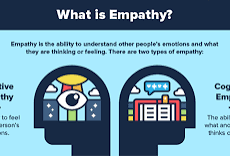The Connection Between ASD and Empathy
Autism Spectrum Disorder (ASD) is a complex neurodevelopmental condition that affects how a person perceives the world and interacts with others. While individuals with ASD may struggle with social communication and interaction, there is a growing body of research that challenges the notion that they lack empathy.
Empathy, often described as the ability to understand and share the feelings of others, is a fundamental aspect of human relationships. People with ASD may experience empathy differently than neurotypical individuals, but this does not mean they are devoid of it.
Studies have shown that individuals with ASD may have difficulty recognizing and interpreting social cues, such as facial expressions and body language, which can impact their ability to empathize in traditional ways. However, many people with ASD demonstrate empathy through different means, such as showing concern for others’ well-being or expressing emotions in unique ways.
It is important to recognise and appreciate the diverse ways in which empathy can be expressed. By understanding and accepting these differences, we can create a more inclusive society that values the contributions of individuals with ASD and other neurodivergent conditions.
Ultimately, fostering empathy towards individuals with ASD involves promoting understanding, patience, and acceptance. By embracing diversity in all its forms, we can build a more compassionate world where everyone’s experiences are valued and respected.
Five Tips for Enhancing Empathy and Communication with Individuals on the Autism Spectrum
- 1. Be patient and understanding when communicating with someone with ASD who may struggle to express empathy.
- 2. Use clear and direct language to convey your own feelings and emotions, as individuals with ASD may find it easier to understand explicit communication.
- 3. Encourage the individual with ASD to practice perspective-taking exercises to help them understand others’ emotions and viewpoints.
- 4. Provide social stories or visual aids that illustrate different emotions and appropriate responses in various situations.
- 5. Foster a supportive environment where individuals with ASD feel safe expressing their own emotions and can learn from positive social interactions.
1. Be patient and understanding when communicating with someone with ASD who may struggle to express empathy.
When communicating with individuals with Autism Spectrum Disorder (ASD) who may find it challenging to express empathy, it is crucial to practice patience and understanding. Recognising that they may perceive and convey emotions differently can help create a supportive environment where meaningful connections can be fostered. By allowing space for their unique communication styles and being patient in interactions, we can bridge understanding gaps and cultivate empathy in ways that resonate with their experiences.
2. Use clear and direct language to convey your own feelings and emotions, as individuals with ASD may find it easier to understand explicit communication.
When interacting with individuals with Autism Spectrum Disorder (ASD), it is beneficial to use clear and direct language to express your own feelings and emotions. People with ASD may find it easier to understand explicit communication, as it helps them interpret social cues more effectively. By articulating your emotions in a straightforward manner, you can enhance mutual understanding and strengthen the connection between yourself and individuals with ASD, fostering a more supportive and inclusive environment for meaningful interactions.
3. Encourage the individual with ASD to practice perspective-taking exercises to help them understand others’ emotions and viewpoints.
Encouraging individuals with Autism Spectrum Disorder (ASD) to engage in perspective-taking exercises can be a valuable tool in enhancing their understanding of others’ emotions and viewpoints. By practising putting themselves in someone else’s shoes, individuals with ASD can develop empathy skills that may not come naturally to them. These exercises can help bridge the gap in social interactions and foster deeper connections with others by encouraging a more nuanced understanding of different perspectives and emotions.
4. Provide social stories or visual aids that illustrate different emotions and appropriate responses in various situations.
Providing social stories or visual aids that illustrate different emotions and appropriate responses in various situations can be a valuable tool in supporting individuals with Autism Spectrum Disorder (ASD) to understand and navigate social interactions. These resources can help individuals with ASD to recognise and interpret emotions more effectively, enhancing their ability to empathise with others and respond appropriately in different social contexts. By utilising visual aids tailored to their needs, individuals with ASD can develop essential social skills and improve their communication abilities, fostering greater empathy and understanding in their interactions with others.
5. Foster a supportive environment where individuals with ASD feel safe expressing their own emotions and can learn from positive social interactions.
Creating a nurturing environment where individuals with Autism Spectrum Disorder (ASD) feel secure in sharing their emotions is crucial in fostering empathy. By cultivating a supportive space that encourages positive social interactions, individuals with ASD can develop their emotional awareness and understanding of others. This approach not only enhances their own well-being but also promotes a culture of empathy and acceptance within the community.


